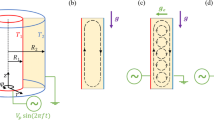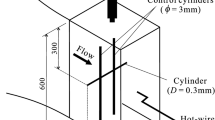Abstract
Electrically heated cylindrical wires are used in research and industry for fluid velocity and turbulence measurements. At very low free-stream velocities (u≤0.1 m/s), hot-wire measurements are significantly influenced by buoyant convection. Below a certain Reynolds number Re* this effect degrades the accuracy of the measurements. To assess the contribution of free-convection heat transfer to the heat balance of hot-wires in cross flow, measurements under normal gravity and microgravity (µg) conditions are compared keeping all other parameters constant. Under gravity conditions, the acceleration of gravity, the hot-wire axis and the direction of the free stream are all perpendicular to each other. The microgravity experiments were carried out in the Drop-Tower Bremen in which the residual acceleration is less than 10−5 g during a period of 4.7 s. The present investigation is concerned with a velocity range of 0≤u≤0.35 m/s corresponding to a Reynolds number range Re<0.1 in standard air. This range includes pure free convection for Re→0 and forced-convection-dominated heat transfer for Re=0.1. At intermediate Reynolds numbers both transport mechanisms must be considered.
Similar content being viewed by others
References
P. Freymuth: Bibliography of thermal anemometry, TSI Inc., St. Paul, MN, USA, 1992.
H. H. Bruun: Hot-Wire Anemometry: Principles and Signal Analyses, Oxford University Press, 1995.
M. A. Kegerise andE. F. Spina: A comparative study of constant-voltage and constant-temperature hot-wire anemometers: Part 2 — the dynamic response, Exp. in Fluids, vol. 29, pp. 165–177, 2000.
D. C. Collis andM. J. Williams: Two-dimensional convection from heated wires at low Reynolds numbers, J. Fluid Mech., vol. 6, pp. 357–384, 1959.
L. D. Landau and E. M. Lifschitz: Hydrodynamik; Lehrbuch der Theoretischen Physik, Verlag Harri Deutsch, 1991.
P. J. Christman andL. Podzimek: Hot-wire anemometer behavior in low velocity air flow, J. Phys. E. Sci. Instr., vol. 14, pp. 46–51 (1970).
A. P. Hatton, D. D. James, andH. W. Swire: Combined forced and natural convection with low-speed air flow over horizontal cylinders, J. Fluid Mech., vol. 42, pp. 17–31 (1970).
F. R. Stengele andH. J. Rath: Influence of free convection on the heat transfer from hot-wire probes, Wärme- und Stoffübertr., vol. 29, pp. 299–307 (1994).
L. J. S. Bradbury andI. P. Castro: Some comments on heat-transfer laws for fine wires, J. Fluid. Mech., vol. 51 (3), pp. 487–495 (1972).
A. Abdel-Rahman, C. Tropea, P. Slawson, andA. Strong: On temperature compensation in hot-wire anemometry, J. Phys. E: Sci. Instr., vol. 20, pp. 315–319 (1987).
VDI-Wärmeatlas, VDI, 7. edition, 1994.
R. P. Dring andB. Gebhart: Hot-wire anemometer calibration for measurements at very low velocity, J. Heat Transfer, ASME, vol. 91, pp. 241–244 (1969).
L. P. Chua, H.-S. Li, andH. Zhang: Calibration of hot-wire for low speed measurements, Int. Comm. Heat Mass Transfer, vol. 27, pp. 507–516 (2000).
G. E. Andrews, D. Bradley, andG. F. Hundy: Hot-wire anemometer calibration for measurements of small gas velocities, Int. J. Heat Mass Transfer, vol. 15, pp. 1765–1786 (1972).
R. L Mahajan andB. Gebhart: Hot-wire anemometer calibration in pressurised nitrogen at low velocities, J. Phys. E: Sci. Instr., vol. 13, pp. 1110–1118 (1980).
D. C. Collis andM. J. Williams: Free convection of heat from fine wires, Aeronautical Research Laboratories, Melburne, vol. 140, pp. 1–23 (1954).
L. V. King: On the convection of heat from small cylinders in a stream of fluid, Phil. Trans. Roy. Soc. London, vol. 214 (A), pp. 373–432 (1914).
J. Cole andA. Roshko: Heat transfer from wires at Reynolds number in the Oseen range, Proc. Heat Transfer and Fluid Mech. Inst., pp. 13–23, University of California, Berkeley (1954).
C. A. Hieber andB. Gebhart: Low Reynolds number heat transfer from a circular cylinder, J. Fluid Mech., vol. 32 (1), pp. 21–28 (1968).
TSI GmbH, Ziegler Str. 1, 52078 Aachen, Germany: Innovation in Thermal Anemometry, 1998.
H. Schlichting and K. Gersten: Grenzschicht-Theorie, Springer, 9. edition, 1997.
F. A. Koch andI. S. Gartshore: Temperature effect on hot-wire anemometer calibrations, J. Phys. E: Sci. Instr., vol. 5, pp. 58–61 (1972).
Author information
Authors and Affiliations
Corresponding author
Rights and permissions
About this article
Cite this article
Henselowsky, C., Kuhlmann, H.C. & Rath, H.J. Investigation of the influence of free convection on the heat transfer of cylinders with different aspect ratios. Microgravity sci. Technol. 13, 43 (2002). https://doi.org/10.1007/BF02872076
Received:
Revised:
Accepted:
DOI: https://doi.org/10.1007/BF02872076




